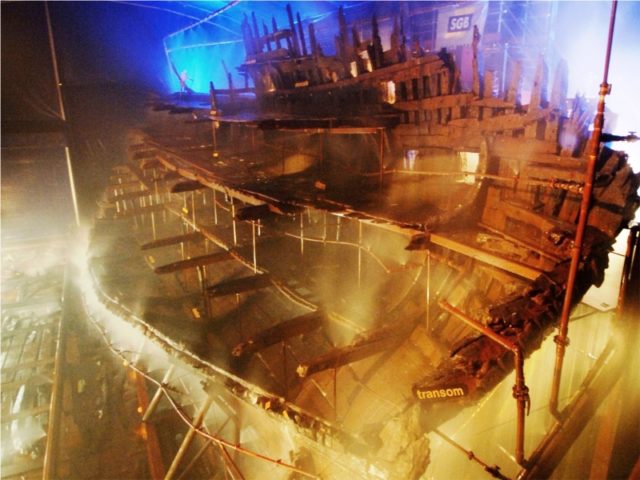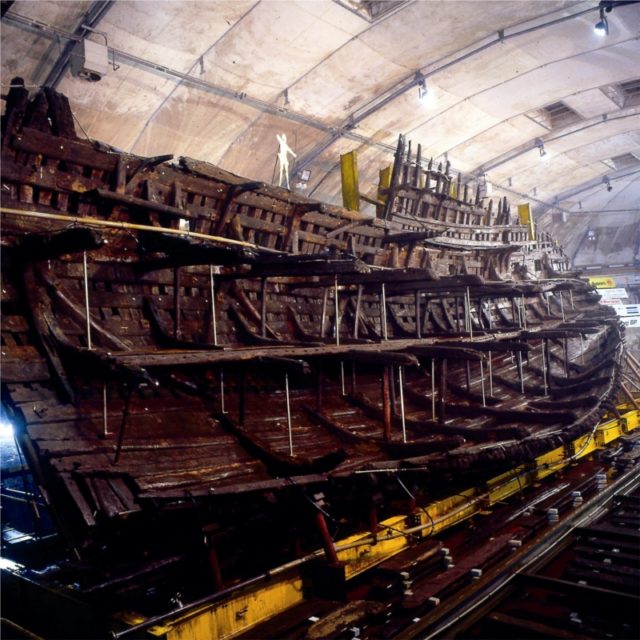Henry the VIII watched as the pride of his fleet went forth into battle against the French. The Mary Rose turned sharply in order to line up a broadside against the enemy and the ship started to keel over, water gushing through the open gunports.
Within no time, she at the bottom of the Solent, with only 35 left of the 500 strong crew to share the tale. The catastrophe of the Mary Rose‘s sinking happened almost 500 years ago.

Since then, almost no one – bar a select team of experts and conservationists – has seen the Mary Rose close up and in the flesh. That is, until July of this year. After $66 million and 34 years of restoration work, the beautiful ship was revealed to the public in Portsmouth.
Over 60 million people watched on TV in 1982 as the wreck of Mary Rose was dragged to the surface following an 11-year salvage operation. Amongst those who participated in the 28,000 dives in the process of recovering the ship’s contents was the Prince of Wales, who is an ardent fan of this project. The moment she came ashore, however, the Mary Rose‘s frame had to be sprayed endlessly with water in a carefully controlled environment to prevent further damage.

From 1994 to 2013, it was tightly sealed within an artificial mist of soluble wax and chilled water. For the past three years, the ship has experienced a graduated drying process, leading to yesterday’s grand introduction. Now, for the first time, the public can enjoy an uninterrupted view of the entire structure with the absence of a glass panel, or a cloud of water.
They can witness how tall this ship was, and why it took 600 oaks to produce it. The vessel, Henry VIII’s ship, has appeared on display within the newly reconditioned Mary Rose museum precisely 471 years subsequent to its demise in the Solent on July 19, 1545.
They’ve installed some digital projection equipment, so people can see virtual reality scenes of the crew going about their own business.
This ship is said by Tudor historian Dr. David Starkey to be a time capsule richer than Tutankhamun’s Tomb, Herculaneum, and Pompeii. The Mary Rose was a terrible loss to Henry the VIII, but she has proved to be a great treasure for modern historians.
While important Tudor palaces, such as the Hampton Court, still stand, they boast only a handful of original Tudor artifacts. The Mary Rose went down with hundreds of mugs and plates, surgical tools (such as syringes for venereal disease), immense cooking cauldrons, barrels of food, and bottles of booze. Amongst the countless musical instruments found, there was a flawlessly preserved Tudor violin.

Amongst the key finds was an arsenal of about 200 yew longbows and a vast supply of armor-piercing arrows. They were taken to one of the world’s leading authorities of longbow restoration. The Mary Rose longbows turned out to be more powerful than anyone has suspected; it was calculated that several had a draw weight equal to 160 pounds.
That is nearly four times the draw weight of a modern day Olympic bow, and has the capability of piercing a suit of armor from a quarter of a mile off. Now, historians can understand why Henry V had six times more archers at Agincourt than other men at arms.
For the conservationists, this has been a long challenge against more than the atmosphere and the elements. A decade ago, with money becoming scarce, there were doubts whether the Mary Rose would be capable of staying on public display. When the Lottery grant was turned down due to the lack of an “audience development plan”, a large-scale public campaign eventually saw the decision reversed.
In actuality, a great deal of the ship, including the forecastle and the rudder, is still on the seabed, waiting for a benefactor willing to fund another salvage operation. There are still countless mysteries yet to come up from the mud. It has been an extraordinary accomplishment to get this far, and now the public can witness the results.
